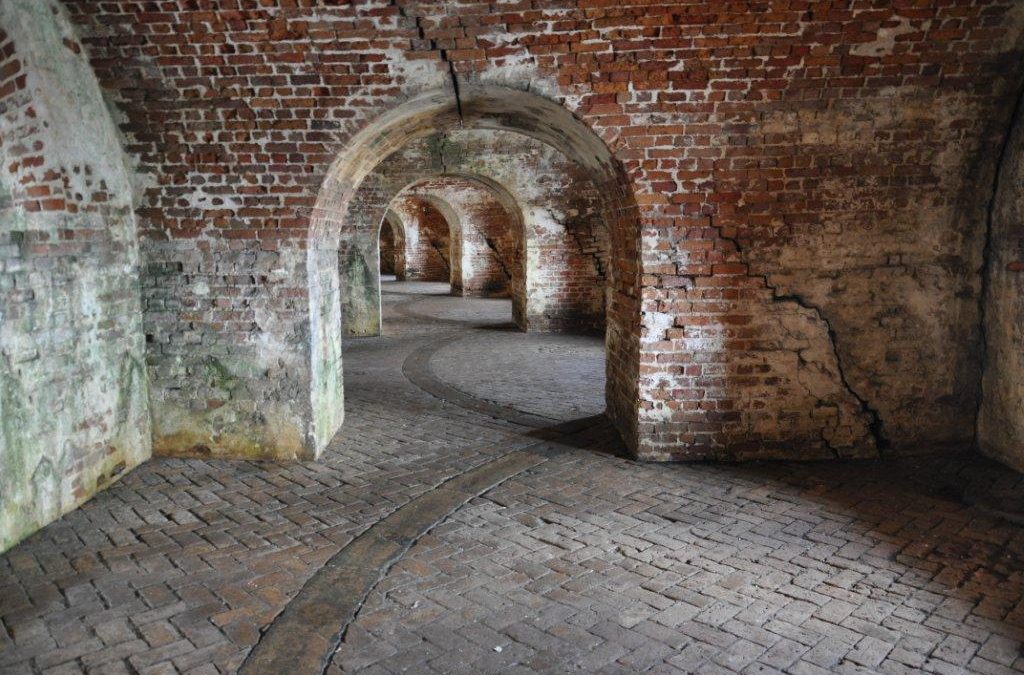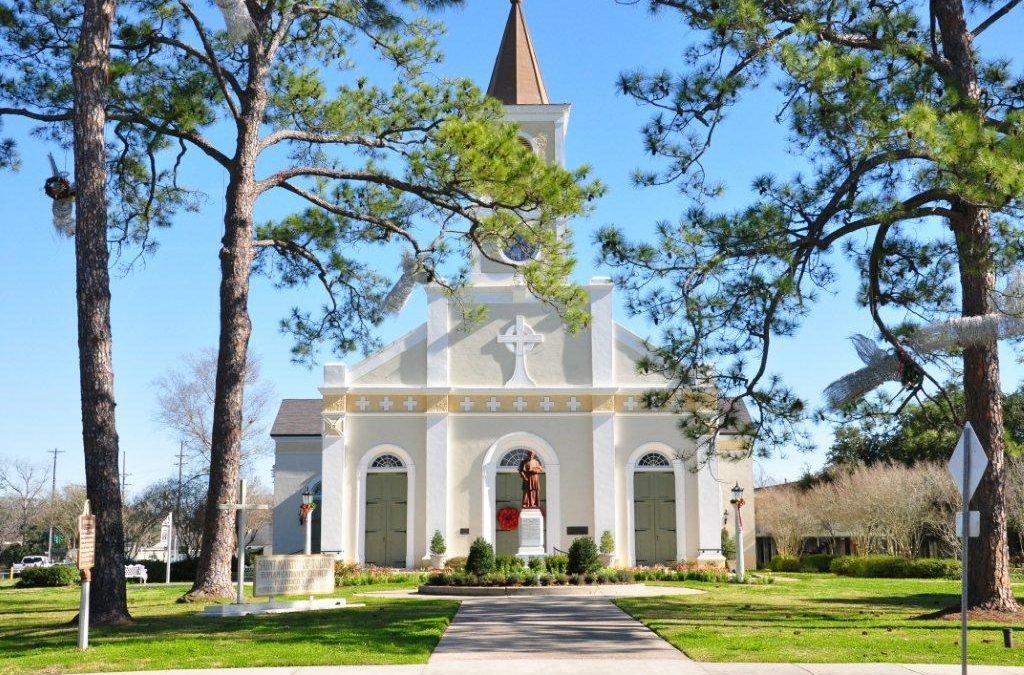
by admin | Jan 25, 2012 | Greater New Orleans
Beyond a line of Vietnamese stores and restaurants, Chef Menteur Highway journeys to the far edges of New Orleans, deep into the nation’s largest urban National Wildlife Refuge. Just a short distance from our house,
Bayou Sauvage NWR is a flashback to what much of this area used to look like – or perhaps more of what the natural landscape has become.
 |
| Fort Pike on The Rigolets Pass |
|
 |
| Bayou Sauvage National Wildlife Refuge |
As we took our time unfolding strollers and loading in kids and snacks, a rush of cars filed into the previously empty parking lot. Almost on cue, doors flew open and members of the Slidell Hiking Club emerged. While they milled around the display of posters describing the refuge, we scooted down the boardwalk out of sight.
There was no water standing under the wooden walkway, and 3-year-old Charles seemed thoroughly confused as to why we couldn’t walk on the ground. We distracted him from his interrogation with a challenge to race. The end of the 2/3 mile trail came sooner than expected, and we unbuckled August and let him stretch his legs while we took in the expansive landscape in front of us.
The entire route had been enveloped with short vegetation and an occasional live oak. Here, at the end, though, short cypress knees and stubby tree trunks were all that remained from the saltwater damaged and logged forest. The landscape was strangely barren at first glance, but when we looked deeper, there were signs of life everywhere. Far in the distance, an island of live oak trees towered over the flat land, marking the spot where Tchefuncte Indians once built ancient shell middens.
 |
| Abandoned Fort Macomb |
As the Slidell hikers approached, we finished off the loop and continued out Chef Menteur toward Fort Pike State Historic Site, pausing first to snap a few pictures of the abandoned 19th century Fort Macomb along the shores of Chef Menteur Pass. Overgrown and crumbling into the waters surrounding it, Fort Macomb appeared to be the forgotten stepchild of the two forts designed to protect Lake Pontchartrain. On the other hand, Fort Pike, which once guarded The Rigolets (French for “Little Ditch”) pass to the lake, was staffed and open for viewing – and for shooting movies apparently. When we arrived this past weekend, the fort was still recovering from serving as the background for “G.I. Joe 2.”
 |
| Great Horned Owl |
While August and I paid the modest $4 entry fee, Paul and Charles began investigating the feathers and other bird parts littering the ground around a large oak tree. One quick glance up, and they were astonished to see a two-foot-tall great horned owl glaring down at them. He’s a permanent fixture in the tree, and as we learned from the park guide, his mate spends her days under the nearby bridge. They meet up at night to hunt and eat.
Across the moat, we entered the cool, brick arches of Fort Pike. Completed in 1828, the fort served in various capacities in the Seminole Wars, the Mexican War and the Civil War. Although aged from time and the elements, the fort was largely intact, complete with the interior citadel stronghold. Rooms are marked to denote their original purpose, such as a bakery, general store and officers’ quarters, and strategically placed cannons look out over the waters beyond. I pushed the stroller up the rooftop ramp, and we carefully made our way around the top of the fortress, watching the pelicans gracefully fly past. I easily imagined myself transported back in time to live here on this serene site, and then I shuddered to realize the soldiers and their bustling activity that would have been happening all around me.
 |
| Inside Fort Pike |

by admin | Jan 18, 2012 | Cajun Country, Most popular
On the eastern edge of Lafayette, a circle of roads connects the historic town of St. Martinville with picturesque Lake Fausse Pointe. This was our weekend destination, and we launched the adventure from the Crawfish Capitol of the World – Breaux Bridge. As we passed under the bridge and over Bayou Teche, the kids jolted from their naps and began fidgeting with anticipation.
 |
| Evangeline Oak in St. Martinville |
The sleepy downtown was filled with antique stores and the promise of amazing treasures, but one glance at the wild-eyed kiddos in back, and we continued south through the countryside to the equally charming town of St. Martinville. As Charles catapulted from the car, he was stopped in his tracks by our friend who had followed along on the trip. Shaking off his momentary confusion, he pulled her along in his quest for new discoveries in Louisiana’s third oldest town.
 |
| St. Martin de Tours Catholic Church in St. Martinville |
The ample grounds of St. Martin de Tours Catholic Church was the perfect location for running off some energy and adding to our rapidly growing collection of twigs. A man removing Christmas decorations drew us to the church’s front doors, and we ducked under his ladder to enter “the Mother Church of the Acadians” – descendants of the French colonists forced out of Nova Scotia during the French and Indian War. The strong smell of incense lingered in the air inside, encircling us as we toured the gated pews and colorful patterns reflecting on the floor from the stained-glass windows.
 |
| Le Petit Paris Cafe |
Before we could go any farther, we crossed the street for burgers and fries at Le Petit Paris Cafe. We were the only patrons in the quaint restaurant, which gave the kids free reign to squeal and play to their delight. The rest of the historic buildings are centered around the church, and we strolled past the Duchamp Opera House and La Maison Duchamp on our way to Bayou Teche and the Evangeline Oak. Immortalized by Longfellow’s poem “Evangeline,” the ancient oak is one of the most photographed spots in the state.
 |
| Cypress trees in Lake Fausse Pointe State Park |
From St. Martinville, we headed out Catahoula Highway past an intriguing oak and pine alley to the levee road that leads to Lake Fausse Pointe State Park. It was here that, after reuniting with some good friends and tearing both their children and ours away from the playground, we set off to discover nature. At one time part of the Atchafalaya Basin, the 6,000-acre park features both boardwalk and canoe trails through the watery home of alligators and bald cypress trees. Although the sounds of our nine-person group tromping through the forest scared away any signs of life, we couldn’t help but enjoy the fresh air and lovely scenery.
On the way out, we traveled the levee road back to I-10, where in the tiny town of Henderson, we enjoyed a seafood-filled dinner at Pat’s Fisherman Wharf. It was dark when we drove away with full bellies and memories of another Louisiana adventure.
 |
| Playing on a natural see-saw at Lake Fausse Pointe |


